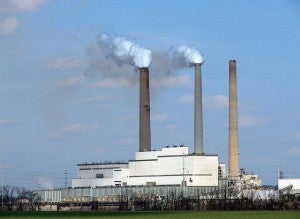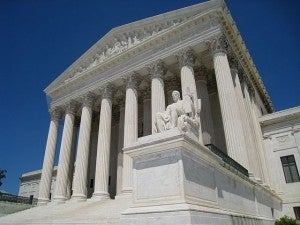The U.S. Environmental Protection Agency (EPA) will soon finalize the Clean Power Plan — a suite of historic Clean Air Act standards that will establish the first nationwide limits on carbon pollution from America’s fossil fuel-fired power plants. Rigorous carbon pollution standards for the nation’s power sector will yield immense benefits for the health of our families and communities, for the American economy, and for a safer climate for our children.
Yet in the months leading up to the release of the Clean Power Plan clean air standards, coal companies and other entities that oppose reasonable limits on carbon pollution have lobbed a series of flawed and failed lawsuits directed at stopping EPA from finishing its work. Now, some power companies and their allies have concocted new – and equally misguided – attacks against the Clean Power Plan.
They’ve been suggesting that the U.S. Supreme Court’s recent decision in the Mercury and Air Toxics Standards case, which held that EPA must take costs into account when making a threshold decision whether to proceed with emissions limits on toxic pollution was a blow against the Clean Power Plan. They’ve also been arguing that states should “Just Say No” to developing plans for implementing the Clean Power Plan’s vital protections to limit carbon pollution for climate and public health.
As we explain below, these critics are flat wrong – on the meaning of the Supreme Court’s decision, on the decision’s implications for the Clean Power Plan, and on the validity of “just saying no.”
Climate and Public Health Benefits of the Clean Power Plan
Before turning to the Supreme Court’s decision, let’s make one thing clear — the “Just Say No” camp is urging states to condemn our families and communities to a future of unlimited carbon pollution and compromised public health. They’re also urging us to forego a tremendous economic opportunity associated with the race to deploy more clean energy solutions, drive down pollution, and increase jobs.
The Clean Power Plan is expected to bring historic health and environmental benefits, both in the near term and for future generations. As proposed, the Clean Power Plan would significantly reduce carbon pollution from the nation’s largest source – existing fossil fuel power plants that account for nearly 40 percent of U.S. carbon dioxide emissions. Reductions of other harmful pollutants will be just as profound. Based on the proposed rule, EPA estimates that by 2030, when the Clean Power Plan is fully in effect, power sector emissions of sulfur dioxide, nitrogen oxides, and particular matter will be reduced by almost 30 percent compared to a business-as-usual scenario. Significant reductions would begin to take place many years earlier.
That means thousands of avoided deaths, heart attacks, and childhood asthma attacks each year — all by the time a child born today starts kindergarten. EPA estimates that the climate and public health benefits of the proposed Clean Power Plan would have an economic value of up to $93 billion per year by 2030 – or as much as eleven dollars for every dollar spent on compliance.
The Supreme Court Mercury Decision and the Clean Power Plan
Yet some opponents of the Clean Power Plan, including Senate Majority Leader Mitch McConnell (R-KY) and large polluters, are urging states to hold off on implementing the Clean Power Plan. They claim — falsely — that the Supreme Court invalidated the Mercury and Air Toxics Standards when it decided Michigan v. EPA, so it was a waste of money for power plants to have complied with the Mercury standards. They say the same thing might happen with the Clean Power Plan.
The Supreme Court did not invalidate the Mercury and Air Toxics Standards. The Court only held that EPA should have taken into account the costs of the standards when the Agency made its initial legal determination that it is “appropriate and necessary” to regulate mercury and other air toxics from power plants. As examined below, EPA considered costs in establishing the resulting emissions standards. Further, the Mercury and Air Toxics Standards remain in effect after the Court’s decision, and power plants are still required to comply. (The case now goes back to a lower court for further consideration).
In the coming weeks and months, EPA will respond to Michigan v. EPA. There is every reason to believe EPA can quickly amend its “appropriate and necessary” finding to address the Supreme Court’s decision, without affecting the substance of the Mercury and Air Toxics Standards. This is because EPA has already conducted an extensive review of both the costs and benefits of the standards, and that review contains overwhelming evidence that the benefits of the Mercury and Air Toxics Standards are vastly disproportionate to the costs.
Controlling air toxics for power plants, for example, will have the important benefit of reducing human exposure to harmful particulate matter – helping prevent 11,000 premature deaths, 4,700 heart attacks, and 130,000 asthma attacks each year. These “co-benefits” have an estimated value of up to $90 billion per year, or up to nine dollars for every dollar projected to be spent on compliance. That figure does not even take into account the critical benefits associated with reduced exposure to the neurotoxic and carcinogenic pollutants regulated under the Mercury and Air Toxics Standards, all of which are emitted by the power sector in huge quantities, and all of which will be dramatically reduced as a result of the standards. There is no question that the Mercury and Air Toxics Standards are “appropriate and necessary” even when costs are considered.
Moreover, the courts will almost certainly keep the Mercury and Air Toxics Standards in place during the interim period while EPA responds to the Supreme Court’s decision. This is a common course of action when the courts find that EPA needs to go back and address legal or technical issues in a Clean Air Act regulation – especially in the situation we face with the Mercury and Air Toxics Standards, where the issues are straightforward to resolve and there are significant public health protections at stake.
The Clean Power Plan — Different Rule, Different Issues
Polluters and their allies are even more off-base when it comes to the impacts of the latest Supreme Court decision on the Clean Power Plan.
The Mercury and Air Toxics Standards case was about a narrow interpretive issue in section 112 of the Clean Air Act — whether EPA had to consider costs in its “appropriate and necessary” finding. Unlike the Mercury and Air Toxics Standards, the Clean Power Plan is authorized by section 111 of the Clean Air Act. Section 111 contains no reference to an “appropriate and necessary” finding. So the Supreme Court’s interpretation of section 112 doesn’t have any direct relevance to section 111.
Under section 111, EPA does have to make a threshold finding that a source category “contributes significantly to air pollution which may reasonably be anticipated to endanger public health or welfare.” EPA already made this finding when it first issued section 111 standards for power plants back in the 1970’s. In 2009, EPA made a further finding that carbon dioxide and other greenhouse gases “endanger public health and welfare” – a finding that the courts subsequently upheld against numerous industry challenges.
It’s also clear that EPA has considered costs extensively throughout the rulemaking process for the Clean Power Plan, as section 111 requires. As noted above, EPA found that the total benefits of the proposed Clean Power Plan exceed compliance costs by a wide margin. This remains true even when considering the climate and public health benefits separately — EPA’s central estimate of the climate benefits alone is $31 billion per year by 2030, or over three –and-a-half-times the cost of compliance. The public health benefits in that same year are valued at an additional $27 to 62 billion.
Cost considerations are woven into the structure of the proposed Clean Power Plan, which maximizes flexibility to enable compliance using the most cost-effective methods available. Indeed, EPA’s approach is vastly less expensive than the “end of the pipe” solutions some of the Clean Power Plan’s opponents claim are the better approach under the law.
Legal Experts Confirm the Strong Legal Basis for the Clean Power Plan
The cynical premise of the “Just Say No” campaign also ignores the chorus of influential legal experts who have affirmed the strong legal basis for the Clean Power Plan. Leading law enforcement officials, former EPA officials, and prominent legal scholars have concluded that the Clean Power Plan is firmly within EPA’s long-standing authority under the Clean Air Act.
A few illustrative statements include:
The Text, Structure, and History of the Clean Air Act Confirm EPA’s Authority to Regulate Carbon Dioxide Emissions from Power Plants Under Section 111(d). —Attorneys General of the States of New York, California, Connecticut, Delaware, Maine, Maryland, Massachusetts, New Hampshire, New Mexico, Oregon, Rhode Island, Vermont, Washington, and the District of Columbia, in brief filed in Murray Energy Corp. v. Environmental Protection Agency, No. 14-1112 (D.C. Cir. Dec. 23, 2014)
The EPA has authority under the 1990 Clean Air Act, an authority affirmed by the U.S. Supreme Court, to set these public health protections against carbon pollution. — Carol M. Browner (EPA Administrator under the Clinton Administration) & Alex Laskey, With New Power Plant Rules, Energy Efficiency Checks All the Boxes
Critics of the [Clean Power Plan] say that President Obama is making an end run around Congress, stretching the law to achieve by executive action what he could not accomplish through the legislative branch. This is flat wrong. More than four decades ago, Congress expressed its clear desire to regulate pollution from power plants, in the form of the Clean Air Act. I know, because I worked on the legislation, including the key part of the act—Section 111—that the Obama administration is using to justify its move. — Leon Billings, The Obscure 1970 Compromise That Made Obama’s Climate Rules Possible
Limiting Greenhouse Gas emissions from existing power plants is the next logical step after the Supreme Court and other courts have upheld EPA’s authority and obligation to address this issue. A system-wide approach provides needed flexibility and reduces costs, as well as encouraging investment in lower-emitting generation. EPA has wisely left the states a lot of discretion rather than mandating specific measures as some had wanted. – E. Donald Elliott, EPA General Counsel under President George H.W. Bush, Obama’s Section 111d Plan Has Support From George H.W. Bush’s EPA General Counsel, Utility Executives
EPA’s approach is neither unprecedented nor unlimited. Since 1970, the [Clean Air Act] has called on states to make policy choices and use their governmental powers in the manner that this rule might require. Indeed, many of the policy choices needed to comply with EPA’s proposal would stem from the special characteristics of the electricity market and not from any new EPA initiative. — William F. Pedersen, Senior Counsel, Perkins Coie, Does EPA’s §111(d) Proposal Rely on an Unprecedented and Legally Forbidden Approach to Emission Reduction?, Environmental Law Reporter (April 2015)
There is just case law building on case law that says, [the Clean Power Plan] is perfectly constitutional. — Prof. Jody Freeman, Harvard Law School, Harvard Law’s Lazarus and Freeman discuss federal court Power Plan hearing, Tribe arguments,E&ENews PM (April 20, 2015)
Clean Air Act regulations of existing power plants implemented by presidents of both parties over the past quarter of a century have achieved vitally important protections for public health and the environment through regulatory tools carefully designed to minimize costs. By following in the footsteps of earlier rules, the Clean Power Plan could be similarly transformative. The claim that it is unprecedented and unconstitutional is wrong on the facts and wrong on the law. – Ricky Revesz, Dean Emeritus and Lawrence King Professor of Law, NYU School of Law, Obama’s professor on Clean Power Plan – Wrong on the facts and law
EPA’s Strong Record of Success in Defending Clean Air Act Rules
Proponents of the “Just Say No” campaign also hope that the public will overlook EPA’s strong track record of success in defending Clean Air Act rules in the nation’s federal courts. Indeed, almost all of the major Clean Air Act rules that have so successfully protected human health and the environment in recent years have undergone intense legal challenges – and most of these challenges have failed.
Consider these recent examples:
- EPA v. EME Homer City Generation (U.S. Supreme Court, 2014) — In a major victory for EPA, the Supreme Court reversed a D.C. Circuit decision invalidating the Cross-State Air Pollution Rule.
- Utility Air Regulatory Group v. EPA (U.S. Supreme Court, 2014) — The Supreme Court upheld EPA’s interpretation of the Clean Air Act requiring that new and modified industrial facilities obtain permits limiting their emissions of greenhouse gases to reflect “best available control technology.” The Court did rule against EPA on the question of whether the “best available control technology” requirement applies to smaller facilities. However, EPA itself had concluded those requirements would pose serious practical problems and yield relatively small pollution control benefits.
- Coalition for Responsible Regulation v. EPA (D.C. Circuit, 2012) — The D.C. Circuit Court of Appeals upheld EPA’s science-based finding that climate pollution endangers public health and welfare, and EPA’s first generation of greenhouse gas emission standards for passenger vehicles. The Supreme Court declined to review either of these critical holdings, laying the groundwork for subsequent rules reducing greenhouse gas emissions from passenger vehicles and medium and heavy duty trucks.
- Delta Construction Co. v. EPA (D.C. Circuit, 2015) – The D.C. Circuit dismissed, on procedural grounds, multiple legal challenges to EPA’s first greenhouse gas standards for medium and heavy duty vehicles.
- National Association of Manufacturers v. EPA (U.S. Court of Appeals for the D.C. Circuit, 2014) — EPA fended off challenges to the National Ambient Air Quality Standards for particulate matter (better known as soot).
The health and environmental benefits of the Clean Power Plan will be invaluable. As EPA prepares for the inevitable legal attacks, it has a strong legal foundation and a track record of litigation success. Nothing about the Mercury and Air Toxics Standards decision changed that.
















